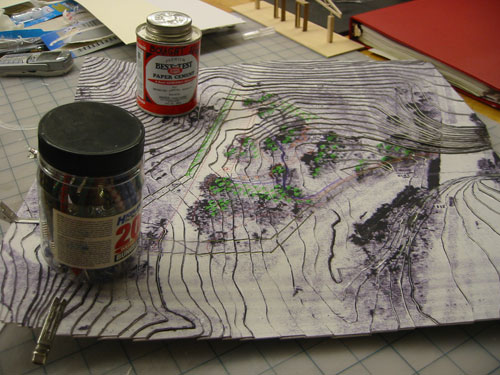
Previous entry:
October 2005
Next Entry:
December 2005
Home:
One Truth For All
| Sun | Mon | Tue | Wed | Thu | Fri | Sat |
|---|---|---|---|---|---|---|
| 1 | 2 | 3 | 4 | 5 | ||
| 6 | 7 | 8 | 9 | 10 | 11 | 12 |
| 13 | 14 | 15 | 16 | 17 | 18 | 19 |
| 20 | 21 | 22 | 23 | 24 | 25 | 26 |
| 27 | 28 | 29 | 30 | 31 |
Archives
November 30, 2005
Crit Day
This is a week of crits. We had a bunch of architects and instructors in today to see our desk setups. Tomorrow our instructor is going from desk to desk critiquing our work. Friday we have our "exit interviews." It's a paradoxical mix of rushing to get work done -- we can work between crits to adapt our designs to the feedback -- and sitting and waiting or listening to somebody rip your work to shreds.
Here's my desk this afternoon:
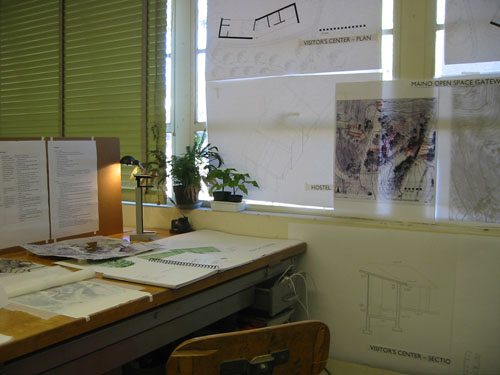
I finished off the site model with a couple of little massing models. They're pretty rough, but I just wanted to show relative size.
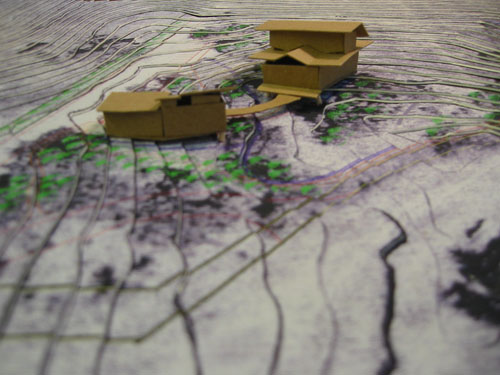
Transforming the room from a workspace into a display space is really hard work. I cleared up my tools and packed them under the desk, then hung white butcher paper over the window to give my drawings something to hang off of.
Some people who weren't next to a vertical surface built walls of board, foamcore, sticks, and paper.
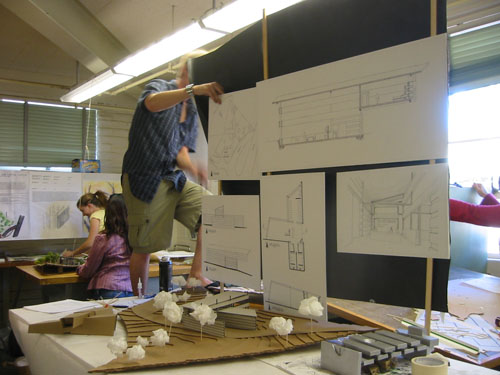
The hard thing is to make the display look like it fits into the design of the project, rather than just being something you stuck your work onto. Here are some of the desk setups in the classroom.
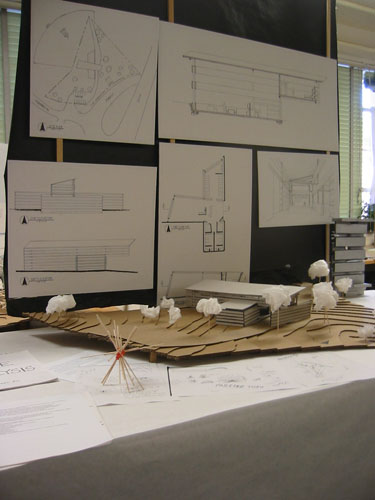
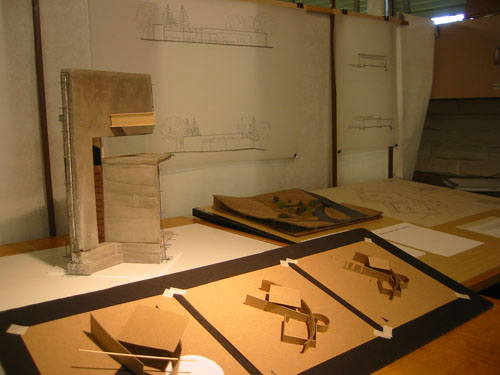
We had to present our projects to various visitors, which meant coming up with a spiel and being able to go through it over and over as new people came by.
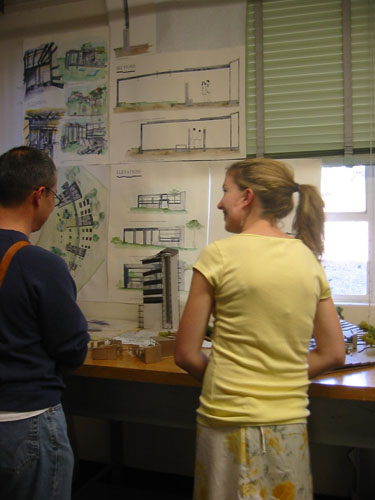
More desk setups:
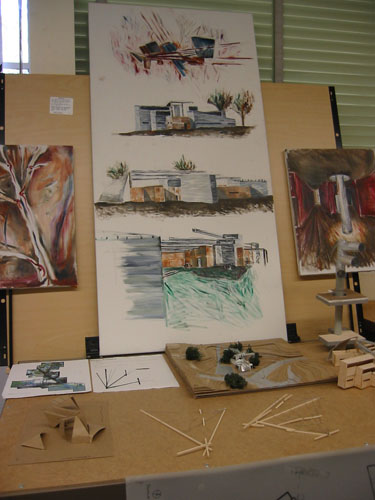
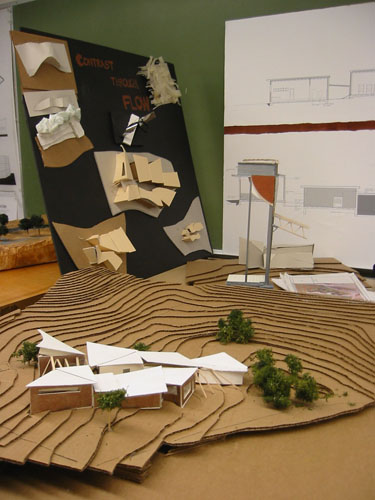
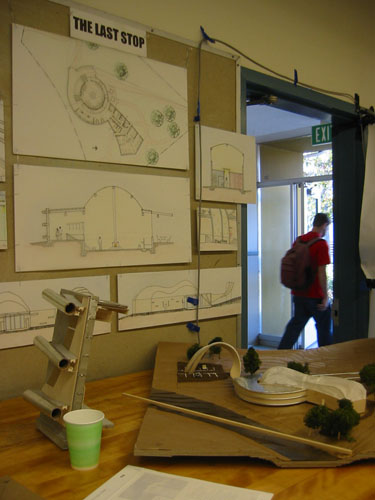
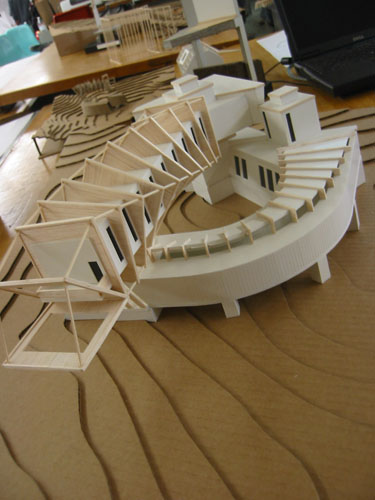
A couple of my classmates built this paper enclosure for their desk setups. It was actually quite cozy, if not entirely structurally stable.
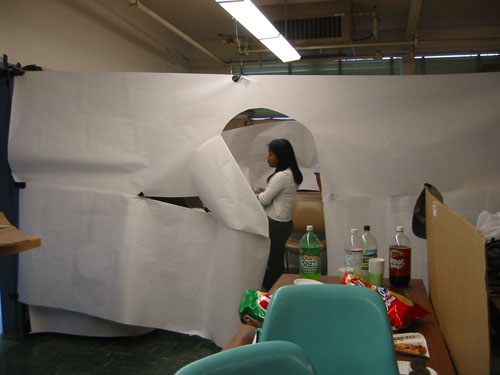
The best part of the crit day is sitting around talking about model building technique with my classmates. When we're working, it's hard to stop and talk about "how did you do that?" -- crit day is our first real chance to take a breath and look at the bigger picture.
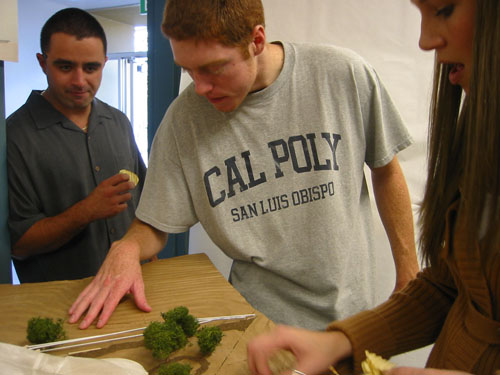
For whatever reason, this has been a really exhausting couple of weeks, and I'm glad to see it coming to a close. There are only two more class days and then finals next week. Then I get to go home and do heavy labour until the holidays.
# Posted by ayse on 11/30/05 at 10:53 PM | Comments (0)
November 29, 2005
Crit Eve
Tomorrow afternoon, a half dozen architects descend on my studio to discuss what I've been doing all quarter.
Tonight, I stayed late and managed to bruise two fingers making this (the glue and the bottle of mini-bungie cords are holding it while the glue sets):
It's a 1/32" scale topographic model of my site with the plan drawn on it. Tomorrow I will drop in some small cardboard massing models where the two buildings are on the site, but the bruising on my fingers is bad enough that now I need to give them a rest from cutting board. And some sleep would be nice, too.
# Posted by ayse on 11/29/05 at 11:34 PM | Comments (0)
November 28, 2005
Stupid Pens
I have a set of technical pens, Rapiographs, and they are the biggest whiney babies of the pen world, I swear to god. Today, as I'm drawing details onto my final studio drawings, they are cloggy and spitty, and my hands are covered in black ink. I do need to give them another go through the ultrasonic cleaner, but I think some of the finer nibs need to be replaced, especially the one in which I made the collosal mistake of using white ink -- official Rapidograph ink, but it turned out to be cloggier than the fine black ink that's the standard.
I'm on the edge of just trashing the set and replacing them with Rapidoliners, which are the same basic thing but with disposable ink cartridges that incorporate the nibs, so every time you refill you get a fresh, unclogged nib. I am about to walk up to the campus store and see if they have anything in a double-ought (0.30mm for you metric types) technical pen for a reasonable amount, because mine just, well, blew up. I wonder if you get a discount for coming in covered head to toe in India ink.
Also in the misbehaving studio supplies this year are the metal 18" ruler with cork backing that has been shedding the cork backing despite repeated re-gluings, and the 36" metal straightedge that... well, who knows what happened to it, but it is no longer in my bin of rulers, nor is it anywhere in the studio, so all I can imagine is that it has made its escape after years of putting up with me using it to knock objects off high shelves. Oh, yeah, and the parallel rule for my drawing board (which, admittedly, I never use any more) snapped a connector and is no longer parallel. I'm trying to decide if the repair is worth it.
Of course, everything has to break or need maintenance right when we're 24 hours from deadline in studio.
# Posted by ayse on 11/28/05 at 2:05 PM | Comments (0)
November 24, 2005
Where Are You From?
I've been listening to some post-analyses of the Paris riots lately, and though it might seem like a stretch, what they made me think about is really appropriate for Thanksgiving.
I think of Thanksgiving as the ultimate American holiday of patriotism. More so than any of the days to commemorate wars, or the Declaration of Independence. While it's true that those are significant steps in our history as a country, Thanksgiving is special because it shows how we can grow and change as a culture.
As we all know, Thanksgiving was invented from whole cloth as a myth to try to bring the country together during the massive political rift of the Civil War. I happen to think that this is something we need right now, when our President is actively campaigning to rip the country in half, and when there are actually Americans who believe that if you don't follow him with blind faith, you should be tried for treason.
The myth of Thanksgiving is an interesting one, and somewhat telling. The details have changed over the years as our culture has changed. But at its root is the idea that no matter who we are, we are all Americans, and we are all here together. This is something that really is lacking in Europe: the Europeans think of themselves as privileged because they got there first, somehow entitled to hold their ancestry over immigrants' heads.
Oh, yes, the Europeans didn't lose a war they were not prepared to fight, then undergo genocide and diaspora when the Algerians and Turks started coming to Europe, and that gives them a stronger position to negotiate from, but for the most part the Indians (I'm not going to get into stupid euphemisms about "First Nations" or whatever -- the people who were here when Europeans got here are traditionally called Indians in English just like Algerians are traditionally called Arabs in French; it isn't a slur if it's not used as one) didn't care whether there were white people living in what would become the US, too. It was the white people who wanted all the land for themselves, and also all the animals.
The way immigration is handled in Europe seems bizarre from an American perspective. For one thing, they're just not used to the idea that people from other places can come and live there, and that those people might want to retain some of the traditions of the place they came from. In France, there is a mythical ideal of egalité that says that all people should be equal. This equality, we are told, comes only from absolute cultural assimilation. If you want to be French in France, you have to do things the way the French do, rather than the way you have always done them. Your cultural traditions have no value there, but the reward for that is supposed to be really becoming French.
It's a lie.
In France, you could be fourth-generation native Parisian, speaking no language but French, never having set foot outside the country, but if your name is Ahmed Hassan, you are not and cannot ever be really French. This is the essential lie of cultural assimilation: the French as a culture pretend that if an immigrant absorbs their culture and values, they will be treated like any Frenchman, but that is simply not the case. That person will never be accepted into the mainstream French culture, will never be the image projected to the world of what it is to be French in the 21st century. And they know that almost immediately.
This is why people rioted in France. People don't riot because they are poor. They don't riot because they are unemployed and disenfranchised. They just don't. And for heaven's sake they don't riot, as some have suggested, because they are muslim. Anybody who thinks the Paris riots were caused by those factors is understanding the issue as well as a doctor who hears that you've got a pain in your lower right side and suggests it might have been something you ate.
People riot because not only do they have nothing (or nothing worthwhile) to lose, but also because they have sufficient evidence that they have nothing to gain from continuing to comply.
What does that mean? That means that there's a good reason why there aren't mass riots in cities all over the world when employment falls, in places where there is a large economic disparity. Riots happen when it becomes clear that playing by the rules will not get what is promised.
I contrast the culture in France with America all the time. We've been talking about maybe going abroad for a couple of years, and one of the things I would like to do is tear down the cités in the Paris banlieux and put more culturally appropriate housing there, something that helps build community instead of creating a commuter culture. I doubt I would actually get to do that, but it's something a lot of European capitals are going to need to do to recover from the dehumanizing modernism of the 1950s.
My previous experience with France was feeling like an extreme outsider when I felt human at all. Not because of language -- I was fluent in French and still find myself thinking in that language sometimes -- but because people were nice and welcoming to me until they heard my name, which is strongly associated with immigrant Algerians. When they hear my name they would cringe and make some remark on my [insert insulting racist term here] name. I learned a lot of nasty slang in France. They didn't want me to be different. They wanted me to be exactly like them before they could treat me like a fellow human being.
After my experience being treated like a non-human in France, I was so relieved to come home to America and feel like I belonged. I know that everybody experiences American culture differently, but for the most part, I've never heard of or seen racism as horrible and overt in the US as I experienced in France. (Go ahead, tell me I'm naive or blind. I've left out specific examples because I'm not interested in playing that particular game.)
How does it happen that in the US, you also give up some bits of your home culture -- your language, maybe your favourite foods -- but when you are born in the US, you are an American? I think it's interesting that Americans ask everybody where they're from, meaning where their ancestors emigrated from. When basically everybody is an immigrant (and even the folks who were here when the Europeans got here were immigrants), nobody has a claim to original American-ness. And apart from Asian immigrants who seem to be really big on adopting English names, you can have a name strongly associated with your ethnicity here and nobody thinks anything of it, except that you better memorize the meaning of it because everybody will ask you. It was hard growing up with a funky name spelled in a variant alphabet, but I like my name a lot, I identify strongly with it, and while I've always felt different, I've never ever felt like anything other than an American.
So I give thanks today for being in a country that grows and changes, that created a ritual of togetherness at a time of great breach, that has evolved to get more or less socially tolerant, and yet remains one country, indivisible. Happy Thanksgiving.
# Posted by ayse on 11/24/05 at 11:04 AM | Comments (0)
November 21, 2005
Out to Eat
One of our little rituals, on weekends when Noel and the girls come down to SLO to see me, is to go out to breakfast together at the Breakfast Buzz. The Buzz is great because they have a patio, so the dogs can come. And now that they've both been there enough times, the dogs are very happy to turn into the parking lot.


Because breakfast at the Buzz means licking the ground for food scraps, which is like perfect heaven for Labradors. Also, the Buzz always gives me too many potatoes, so there are usually Potatoes From Heaven.
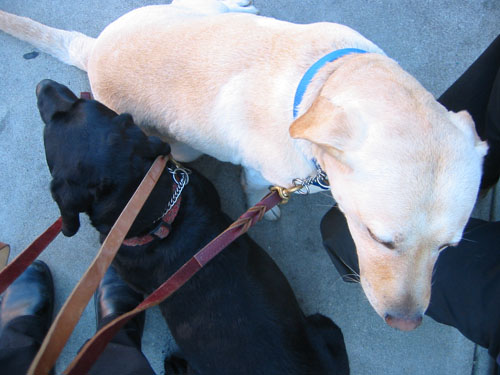
They're both on their best behaviour while waiting.
We always get a lot of people coming up to pet and play with the dogs while waiting for a table (there's always a line unless you get there really early). The owner loves dogs too -- she has a yellow lab -- and sometimes comes over to give the girls a pat. It's funny how many more people come over now that we have Goldie, too; somehow Rosie was terribly intimidating to them because she is black.
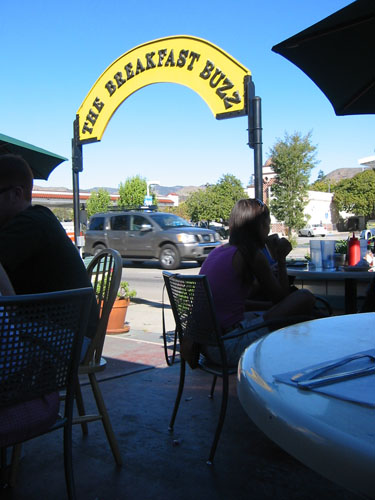
The best part? The food is really good.
# Posted by ayse on 11/21/05 at 11:29 AM | Comments (0)
November 19, 2005
Sunset Walk on the Beach
It's sort of a cliche that personals ads will include a liking for sunset walks on the beach. In our household, we know how really great any kind of walk on the beach can be, at any time of day or night. Even just getting in the car to drive there is exciting.

Going to the beach right at sunset is really lovely. The horizontal light is very flattering. There weren't many people at the beach -- probably everybody went during the day when it was warmer and sunnier.
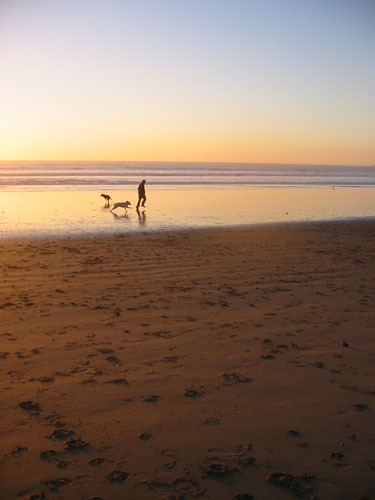
Just a little haze, not the usual heavy fog bank. Some surfers down near Morro Bay, but otherwise not many other people. So there was a lot of running around. The dogs are still napping it off.
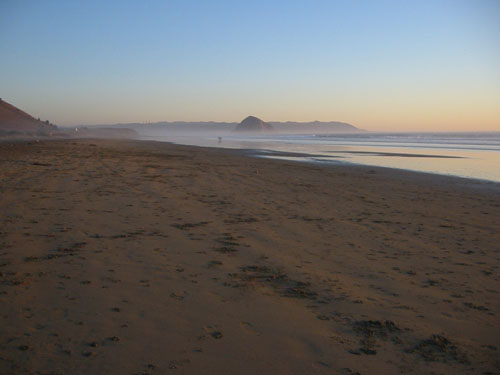
# Posted by ayse on 11/19/05 at 9:57 PM | Comments (2)
November 13, 2005
A Trip and a Model
This weekend the Cal Poly AIAS took a field trip to San Francisco. I joined them for part of it, because I didn't see any point to going to hang out at Fisherman's Wharf but there were two firm tours and a visit to the De Young on the agenda that I was interested in.
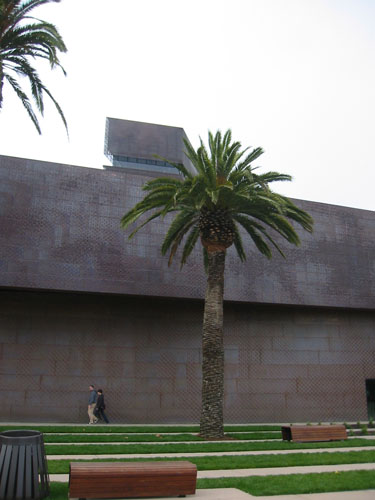
The rebuild De Young museum is nice, but clearly needed more thought given to circulation and usability. You enter a courtyard, and when you get to the door you realize there is a ribboned-off passage to your right, so you have to leave and come back in. Then you get in the door and there are ticket counters to your right, where you stand in line again (no ribbons this time), then there are stands at the entrances to the exhibits that say, "Ticket Check Point," and a lot of people seemed not to understand that they didn't need a special ticket to enter there.
The collection is OK. Not all great but some nice pieces. The museum itself was more interesting, but only in the sense that I found it a good study in how not to make space easy to understand.
Entering the museum, you walk over this installation by Andy Goldsworthy. I love his work, and it was great to see one in person (most of them are ephemeral; the only proof they ever happened is the photo he takes of the piece).
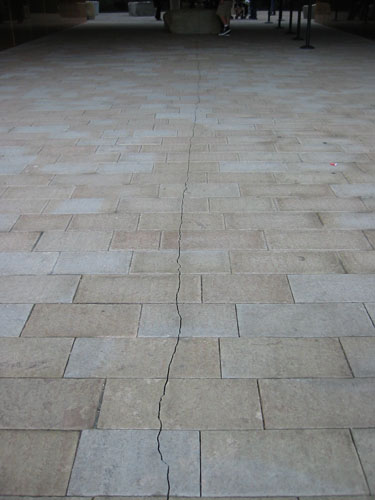
The shape of the museum is broken by this slit that appears and disappears -- very appropriate for a museum that replaces one that was destroyed in an earthquake (as is the Goldsworthy installation with that crack).
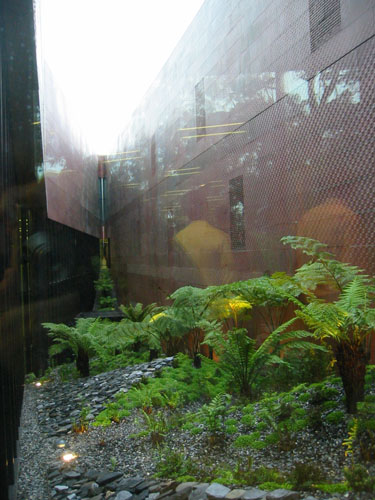
One exhibit I found really compelling was this room full of wire sculptures and their shadows. It seemed more in keeping with the form of the museum than room after room of white gallery walls and hung paintings.
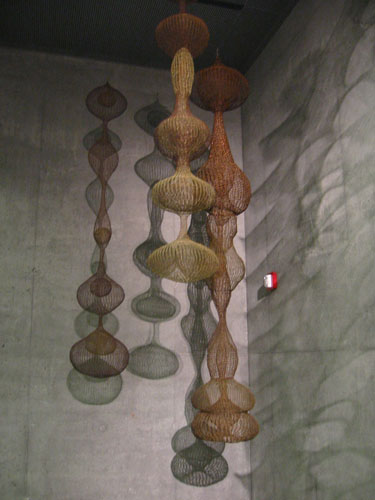
The museum has a nine-story tower, and the observation deck is really stunning. It was fairly foggy, but there was a nice view from the tower even so (you could see the tops of the towers on the Golden Gate Bridge).
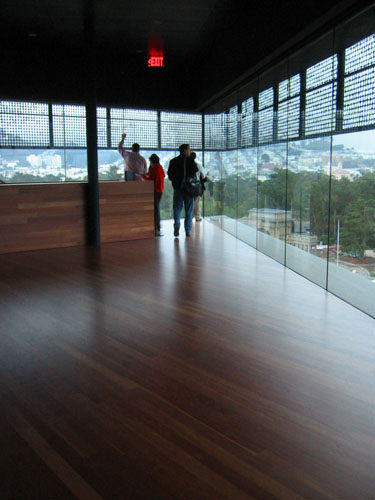
Downstairs, the best white-walls-with-art gallery was this one, where people walking by seemed to be a piece of art on display, and if not for the glass, it would seem like you could just walk out of the museum.
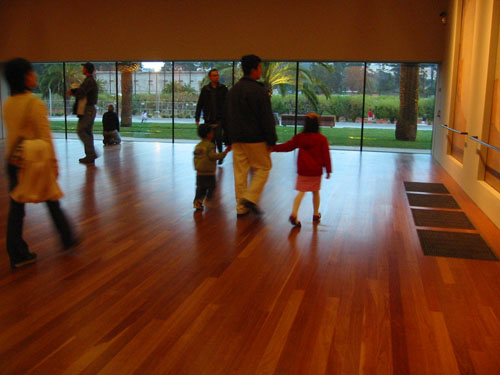
Outside, there is a sculpture garden with this piece in it; most of the other pieces were not lit so I couldn't take pictures (those early sunsets of winter are upon us).
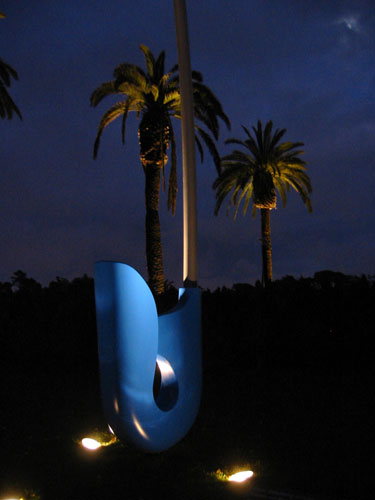
The lighting was not terribly spectacular at night, and the museum seemed to just sort of disappear into the darkness. When that copper siding is all verdigris I'm sure it will be something to behold, though.
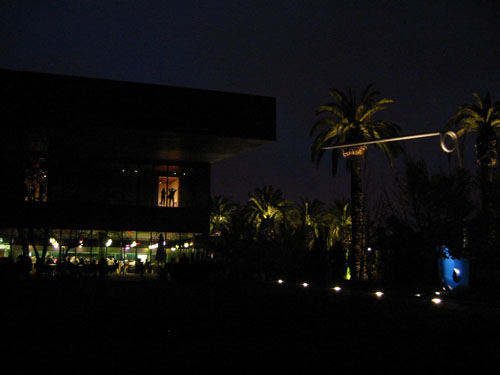
After all that fun, I had to go home and build a study model for engineering, to show the structure of my design project (it didn't have to be my design project; I just chose to make it that).
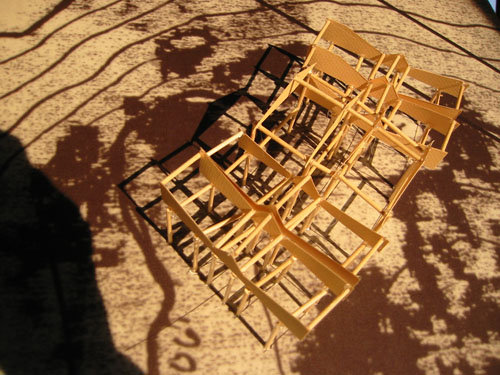
My project is all about circulation, and it would be hard for anybody to show up and not know what to do, what with all the cattle chutes I'm making them walk through. It certainly was interesting to see what can actually get built before anybody asks, "Where is the front door, anyway?"
# Posted by ayse on 11/13/05 at 11:31 PM | Comments (0)
November 8, 2005
Pages of Sketches
I've been filling up my sketchbook with little tiny sketches to get my mind around my design project. The basic shape is good, but a lot of little details in the connections are weird and confusing. I was unsure until last Friday about just how wide this building was going to end up being.
So I have a lot of this:
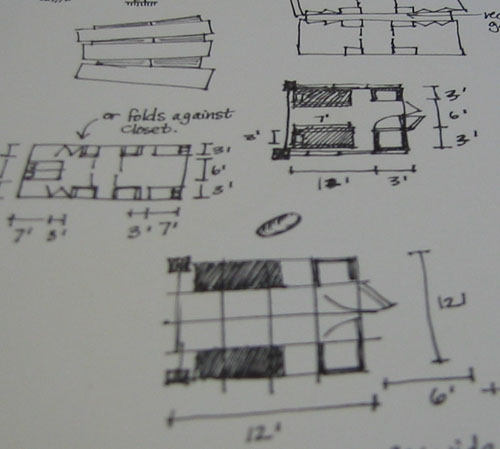
I also threw together a quick slice model on Monday, to get a better understanding of my roof slope. It doesn't look half bad, and I've worked it out so the center hallway (what appears to be between two doors but actually is between two closets) has a tall ceiling, but not mine-shaft tall, while the rooms to the sides have a ceiling that comes down to a reasonable height.
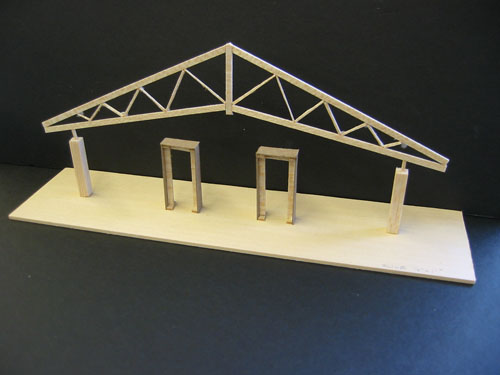
Yes, I am a big fan of the scissor truss. They just seem lighter and more elegant than a plain old triangular roof truss.
# Posted by ayse on 11/08/05 at 9:31 PM | Comments (0)
November 7, 2005
Long Overdue
When I was in France in 1989, and the daughter in the family I was staying with called me Arabe as if she were saying Nigger, I saw in my mind the future for that country. They could either deal with the fact that they had people who were not pure French white people living there, or they would have massive race riots.
At the time, I thought it would be within a year. In hindsight, I was a bit optimistic.
France will come out of this mess a different place. Not a better or worse place, but a different place. Because the only way to stop the rioting now that it has started is not by cracking down on the rioters, but by admitting that a) those suburban developments that Corbu came up with are pure hell, and the cultural disassociation they offer the poor, non-French people who live in them is poison, and b) if you pretend that you can maintain your culture pure and undiluted in a globalized world, you are just plain nuts.
The thing I hated the most about France, and the thing that made me avoid that country for nearly a decade, and feel sick when I used that language, was the racism. When I was in France, I was less than a whole person, not because I had committed a crime, but because I was not from the right genetic background. Only a few months later a black classmate at Stony Brook tried to tell me that I had never experienced racism. You don't have to have dark skin to have somebody tell you you are not entirely human.
I would not have wanted social change through violence. I think social change can and should come about through the concerted efforts of the society itself. But when the ones controlling the government have no interest in the needs of the many, you can chalk me down as unsurprised that the many eventually stop playing by a set of rules that are stacked against them.
# Posted by ayse on 11/07/05 at 12:10 AM | Comments (0)
